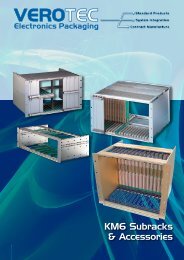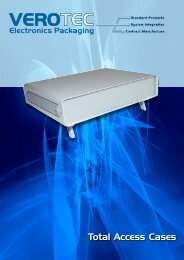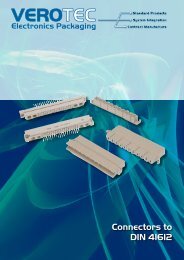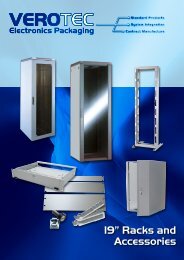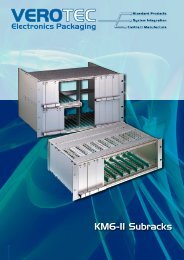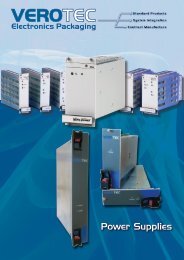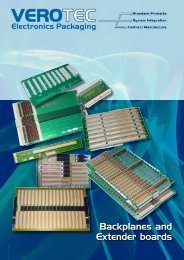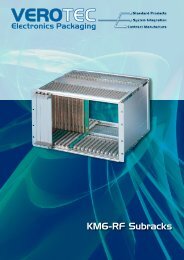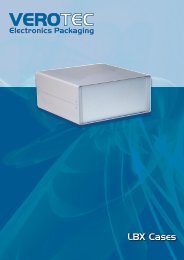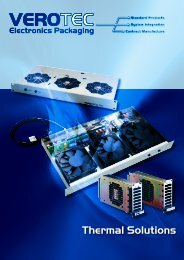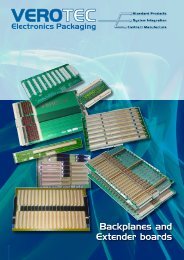Download PDF (1.07 Mb) - Verotec
Download PDF (1.07 Mb) - Verotec
Download PDF (1.07 Mb) - Verotec
You also want an ePaper? Increase the reach of your titles
YUMPU automatically turns print PDFs into web optimized ePapers that Google loves.
Subrack materials and finishes<br />
1 KM6 Subracks<br />
Although aluminium can be seen as a more expensive material than, for<br />
instance, steel, it offers several benefits in the design and construction of<br />
subracks which makes it highly suitable. The reduction in weight which it<br />
offers is particularly useful for ‘one-man’ handling in restricted space and<br />
less than ideal heights.<br />
Additionally, it has excellent heat conduction properties.<br />
In extruded form, it is possible to design-in a wide variety of features which<br />
would be difficult and expensive to incorporate into formed and machined<br />
materials. It also permits easy changes of length.<br />
There are a number of ways of specifying the actual material - we use<br />
BS1474.6063 T6 extrusion.<br />
In sheet form, aluminium can offer good rigidity for its weight and is<br />
relatively easy to punch and half shear accurately, with minimum tool wear.<br />
Our aluminium sheet is BS EN485-2 5251 (H12-H26).<br />
Ideally, from the point of view of corrosion and scuff resistance and for a<br />
good decorative finish, anodising is excellent. Our in-house anodising is to<br />
our own specification and we are rightly proud of the excellent appearance<br />
it produces.<br />
A process known as ‘sub-surface printing’ is ideal where a permanent wear<br />
and chemical resistance are called for, consisting of identification printing<br />
before the application of the anodic film.<br />
Anodic film, which is electrolytically applied is an excellent insulator.<br />
It is therefore unsuitable in modern subrack systems which need to<br />
be electrically bonded due to problems from electrostatics; they also<br />
frequently have to be EMC screened by the application of covers and panels<br />
which must all be electrically continuous as far as possible.<br />
Subrack material and finishes<br />
( V0 is the highest level, V1 being generally as low as we would accept). It is<br />
important to note that the UL94 test has a number of gradations in thickness<br />
and test application.<br />
For that reason, most of <strong>Verotec</strong>’s subrack system components are now<br />
finished by means of a chromate conversion process (typical trade terms<br />
are Irridite, Alocrom, Alodine). This process ensures that the aluminium<br />
materials have a good degree of corrosion resistance, which in turn<br />
prevents ‘self anodising’ over time. Clear chromate has low surface<br />
resistivity (lower than the colour types) but because it is only a surface<br />
film can be affected by scuffing and finger-marking. For that reason, care<br />
should be taken during handling. However, it has a good appearance.<br />
From a production point of view, the use of steel in KM6-RF covers offers<br />
benefits in that it provides stiffness at lower thicknesses.<br />
We use mild steel sheet CR4 to BS EN10130<br />
One of the major problems associated with plastics is their susceptibility to<br />
attack by chemical solvents and we make frequent reference to this. This kind<br />
of damage frequently only shows when the material is under stress (when it is<br />
screwed down, for instance) and is commonly caused by threadlock compounds<br />
or cleaning solvents. Where breakages occur, a sample of the item concerned<br />
can usually establish the nature of the problem.<br />
It is important to note that most plastic components have fine ‘knit lines’ where<br />
the material flows join during the moulding process - they are not normally<br />
deleterious to performance although they are frequently mistaken for incipient<br />
cracks.<br />
In common with most steel components and fixings throughout the <strong>Verotec</strong><br />
subrack range, we use clear passivated zinc plating to provide corrosion<br />
resistance with an acceptable appearance - although the colour passivation<br />
used on tapped strips provides much greater protection against front panel<br />
fixing screws ‘freezing’ in prolonged use or harsh climatic environments.<br />
Moulded plastics are used where complex shaped components are used<br />
in large volumes. There is a huge range of basic materials available,<br />
but in general we are looking for a cost effective plastic that has good<br />
moulding properties, is mechanically and dimensionally stable over a<br />
fairly wide range of temperatures and humidities, and conforms to modern<br />
requirements in fire resistance. The latter is usually expressed as UL94- V*<br />
The addition of glass fibres adds to the strength of moulded components, and<br />
is typically used in applications like injector/ extractors. It is used judiciously<br />
because it tends to accelerate tool wear.<br />
Most of our moulded subrack components are produced in modified PPO<br />
(Polyphenylene Oxide) - typically under the trade names Luranyl or Noryl, or<br />
Polycarbonates - Makrolon for instance. The latter is also supplied in sheet form<br />
for transparent panels.<br />
In the area of EMC seals, there is a general trend to stainless steel, away from<br />
Beryllium Copper. The latter has excellent forming, spring, and conductive properties,<br />
but there is concern about its disposal at the end of equipment life cycles.<br />
1.14<br />
UK Tel: +44 (0)2380-246900 sales@verotec.co.uk<br />
USA Tel: 603.821.9921 sales@verotec.us



